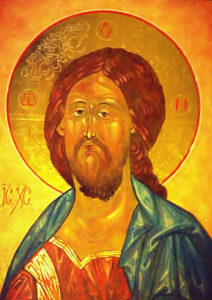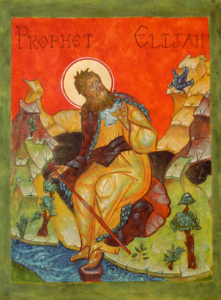Are Icons Idols?
Part Two in the Series, The Image-less Idol: How Iconoclasm leads to Idolatry — Are Icons Idols?
Read Part 1 of the Imageless Idol: Idolatry and Iconoclasm
Thou Shalt Not Make unto Thee any Graven Image: Are Icons Idols?
In Israel’s infancy, a set of laws were bequeathed to the nation and its posterity as inviolable commands. These laws were given to the nation through Moses directly by God in the form of commands. These laws, known as the Decalogue or the Ten Commandments, were intended to govern Israel’s relationship to God and to one another. Within these commands, there is a law that appears to prohibit the use of images, “Thou shalt not make unto thee any graven image, or any likeness of any thing that is in heaven above, or that is in the earth beneath, or that is in the water under the earth (Exodus 20.4a).” It was this command that the iconoclasts would proffer as proof against the use of icons. So we must ask then: are icons idols?

As early as the second century, there were church fathers who warned against the creation of images. St. Melito of Sardis writes:
There are, however, persons who say: It is for the honor of God that we make the image: in order, that is, that we may worship the God who is concealed from our view. But they are unaware that God is in every country, and in every place, and is never absent, and that there is not anything done and He knoweth it not. Yet thou, despicable man within whom He is, and without whom He is, and above whom He is, hast nevertheless gone and bought thee wood from the carpenters, and it is carved and made into an image insulting to God. To this thou offerest sacrifice, and knowest not that the all-seeing eye seeth thee, and that the word of truth reproves thee, and says to thee: How can the unseen God be sculptured? Nay, it is the likeness of thyself that thou makest and worshippest. Because the wood has been sculptured, hast thou not the insight to perceive that it is still wood, or that the stone is still stone? (1)
The iconoclasts saw the Second Commandment’s prohibition against images as a universal and timeless law; no images were permitted. Pagan artists who converted to Christianity and sought to join the church were faced with two options: either find a new profession or risk excommunication. It is not difficult to understand how the first Christians might have found themselves at odds with their pagan environment precisely because of the important role that images played in it. Coming from Palestine as they did, these first Christians must have considered the image to be a form of idolatry, and on the basis of the spiritual character of their religion, they must have also considered any representation of God in art to be a return to paganism. (2) Was the prohibition against images in the Second Commandment, however, literally a prohibition against making any image? A wider look at the Holy Scriptures themselves does not seem to support such a wholesale injunction.
Does the Mosaic Prohibition Against Images Prohibit the Creation of all Art?
When taken in context, the prohibition against images suggests an injunction against the creation and worship of idols, not against all images. “This understanding was clear to the Israelites because even the Hebrew scriptures have references to pictorial depiction, especially in connection with the worship of God. The Tabernacle and the Ark of the Covenant were signs of God’s presence, and both were decorated with cherubim.” (3) This is a fact that was used extensively by the iconophiles in defense of images used in worship. They argued that the iconoclasts had too narrow of a reading of the Holy Scripture and their interpretation was flawed. Saint John of Damascus eloquently dispatched the iconoclasts charges of idolatry, writing on the Second Commandment:
Truly this command is awesome: God, who commands Israel to make no image, or carving, or likeness of anything in heaven or on earth, Himself commands Moses to make graven images of cherubim which are living creatures. He shows a vision of the temple to Ezekiel, and it is full of images and carved likenesses of lions, men, and palm trees. Solomon knew the law, and yet made images, filling the temple with metal figures of oxen, and palm trees, and men, but God did not reproach him on this. Now, if you wish to condemn me on this subject, you are condemning God, who ordered these things to be made, that they might be reminders for us of Himself. (4)
How is it that God can seemingly both prohibit all images and yet order their creation? Saint John of Damascus addressed this apparent contradiction in the Holy Scriptures to prove his argument; for him, there was no contradiction. God was simply prohibiting the use and creation of idols. In answer to the Mosaic prohibition against images, John of Damascus answers using the hypothetical voice of Moses himself; “I did not say, You shall not make an image of the cherubim that stand as slaves beside the mercy seat, but ‘you shall not make for yourself gods of metal,” and “you shall not make a likeness’ as of God, nor shall you worship the creation instead of the Creator’.” (5) The text of the Second Commandment, according to the iconophiles, was never intended to prohibit the creation of all images, instead, the intent had always been to prohibit the worship of idols.

Saint John of Damascus would “trace the tradition of honorable reverence of the sacred object back to the Mosaic people, who venerated on all hands the tabernacle which was an image and type of heavenly things.” (6) Once again, it is a proper relationship to the image that is needed, neither idolatry nor iconoclasm will suffice, for if man is made in God’s image, and the creation is a reflection of His glory, then there must be some proper relationship with the image that is essential to man’s understanding of his relationship with God. While it is believed that “the prohibition against images was aimed at protecting the people of Israel from the danger of idolatry, it must have had another, additional meaning—a positive theological meaning which [is discovered] in the light of the New Testament. Human nature, and with it all of creation, is separated from the Creator; the image of God in man is thus mutilated. In this state of separation, the image has a broken relation with the creator; it expresses a false reality and becomes an idol.” (7) This is an interesting viewpoint; the Second Commandment isn’t merely a negative injunction, but a positive affirmation, and a prefiguring of a future mending of what was broken, namely the image of God in man. The image of God within man was mutilated at the time of Adam’s transgression, separating God from man; this image would be made whole again in the future coming of Christ’s Incarnation. It was on this point, the theology of the Incarnation, that the bulk of the iconodule’s argument would rest. This is a natural interpretation of the Old Testament by the early church who saw most, if not all of the Old Testament, as a shadow of Christ.
In the next installment of the Imageless-Idol, we will take a look at the attitudes of the early church fathers towards icons.
Read the Next Articles in the Series on the Imageless Idol: How Iconoclasm leads to Idolatry
- Introduction: Idolatry and Iconoclasm
- Are Icons Idols? The Mosaic Prohibition
- Early Church Attitudes towards the Image: Icon or Idol?
- The War on Images Begins: The Icoloclastic Controversy
- Post-Iconoclastic Controversies
- Conclusion
References: Are Icons Idols?
(1) Schaff, Phillip, The Twelve Patriarchs, Excerpts and Epistles, The Clementia, Apocrypha, Decretals, Memoirs of Edessa and Syriac Documents, Remains of the First (Edinburgh: T&T Clark, 1885), 755.
(2) Sendler, Egon, Icon: Image of the Invisible (Oakwood Publications, 1988), 11.
(3) Vrame, Anton, The Educating Icon (Brookline, MA: Holy Cross Press, 1999), 31-32.
(4) Vrame, 33-34.
(5) Damascus, St. John, Three Trestises on the Divine Images (Crestwood, NY: St. Vladamir’s Seminary Press, 2003), 65-66.
(6) Cavarnos, Constantine, Byzantine Sacred Art (Institute for Byzantine and Modern Greek Studies, 1985), 34-35.
(7) Sendler, 8.

One Reply to “Are Icons Idols?”